300 camels
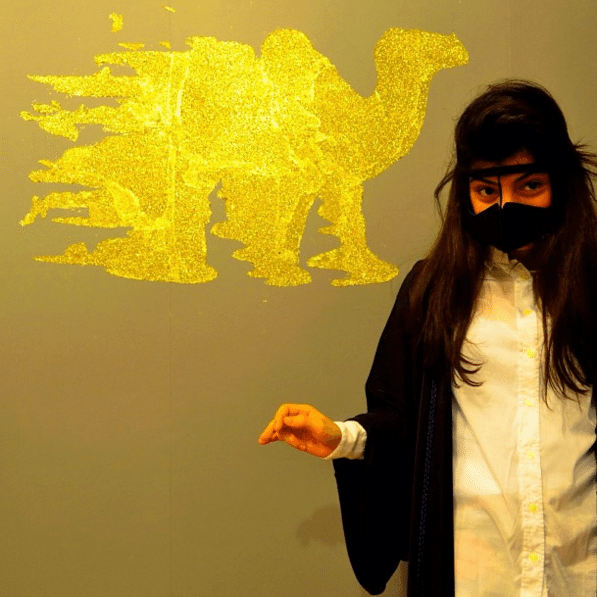
In Saudi Arabia: @rafifaldrees with a golden camel.
Did you walk by a wall recently that had a colourful camel stencilled or pasted on it? If you live in Saudi Arabia – or, for that matter, elsewhere in the world – chances are you might. Back in April this year, 22-year-old “experimental artist and garbage collector” Omamah Ghassan AlsadiQ from Jeddah posted a picture of a world map on Instagram. That was the first image of what has now grown into a large collection of photos, all of them featuring a small camel that seems to be, at the same time, peacefully resting and moving forward.
Omamah calls her project 300 Camels. The idea is to inspire people to draw or paste camels in different locations, then take a picture and share it, until reaching 300. For Omamah, it’s a means of creating collaborative art – “I wanted to let people experiment with street art in a very simple way” – and putting it out in public. The instructions are courteous (“Ladies and gentlemen, this will be your cutting guide”) and easy to follow (“Choose your weapon. Cut the stencil off. Spray it”), and she’s made a model of the camel in three different sizes. At the end of the project, an interactive world map and short film will tell the story of the 300 camels and where they have been.
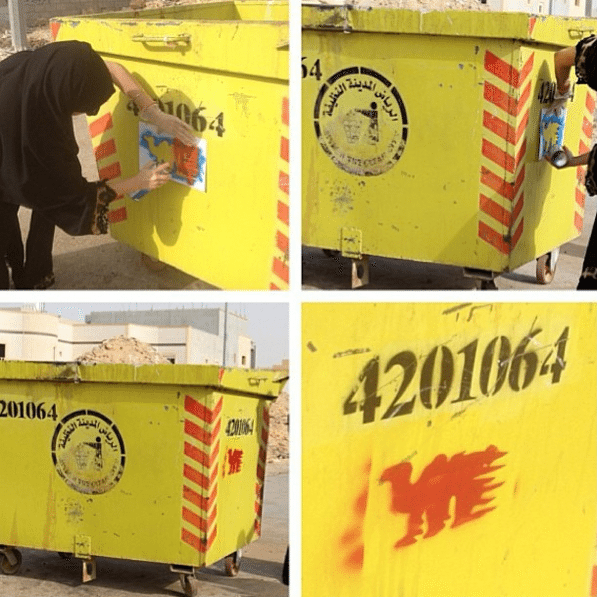
@abeeralmubarak stencils a camel in Saudi Arabia.
The goal of reaching 300 is not far away now – the Instagram feed features over 280 camels and counting. It’s a diverse bunch of animals: some are sprayed in neon colours, others have been calligraphed and ornamented, yet others are decorated with scribbles and drawings. Among them is a camel stencilled on a cracked wall on the outskirts of Amman, another overlooking a lake in Geneva and one in a garden in South Korea. There’s a sky blue camel painted on a shaded wall on Zanzibar, a simple white one outside a tattoo parlour in Mumbai and one matching the stripes on a sand container in Riyadh. In Turkey, a small camel hides in the corner of a large graffiti mural, in China, another is painted on a wall with scribbles in different languages. There’s a pair – one in a shmagh/ghutra (or, as some know it, keffiyeh), another with the traditional Bedouin eye mask – outside the Bahrain fort, and a colourful troupe made by kids geared with spray cans and newspapers in Jeddah.
Omamah says she picked the camel for two reasons: her name, which translates to “camel”, and the fact that it’s an animal that still today symbolises the Arab world. “We live such high-tech lives nowadays,” she says, “always updated on all the latest news.” That’s why she shaped the stencil the way she did: blurry and undefined at its end. “It’s a sign of movement and speed, because the camel is running really fast. It’s a way to counter the stereotypes about us as nomadic tribes still using camels and keeping petrol in bottles.”
At first, Omamah says, she wondered how she would get others to take part in the project. “It was a challenge to me how I would convince people all around the world. But I started doing it myself and then hoped for acceptance. It’s been a kind of proof that young Saudi women – whether artists, lawyers, doctors, teachers, designers or anything else – can stand out and do things.”
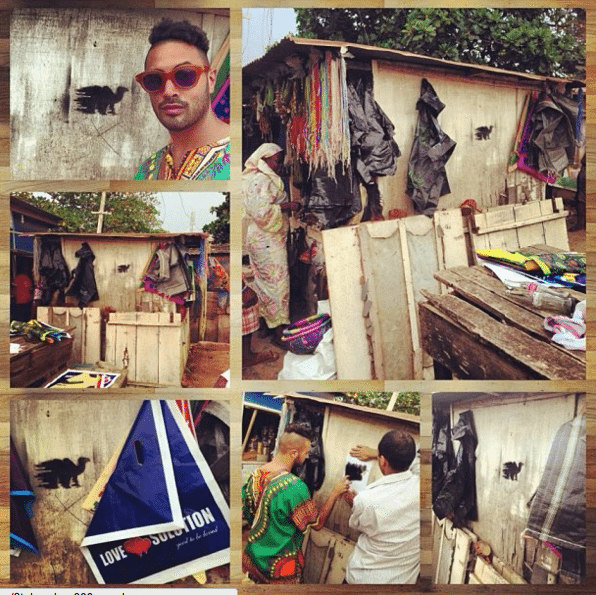
@yolofahad putting up a camel in Ghana.
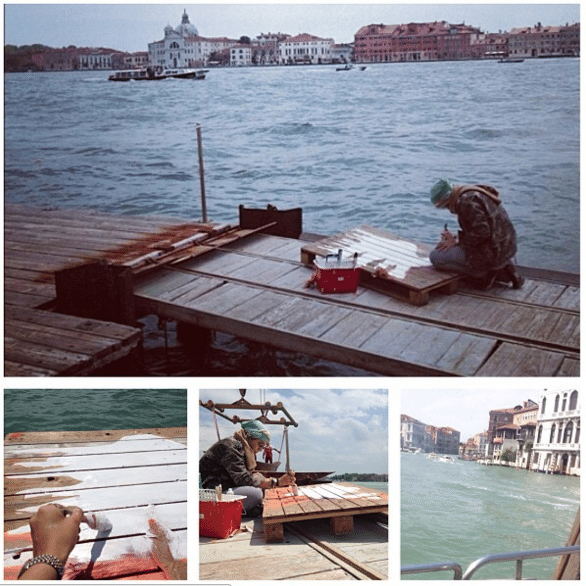
Making a camel for the Venice Biennale.

marbelousb drawing a camel in Oman:
“I think the project is an awesome opportunity. You feel like you’re connecting to others through the camel. Mine was put up in Madinat Sultan Qaboos in Muscat: a lot of teenagers hang out there and I wanted them to see the camel, recognise the project and hopefully do the same. I added tribal patterns, which was fashionable when I made the camel: you could see everyone wearing clothes, bags and shoes with that style. It feel it has an Arabic touch to it.”
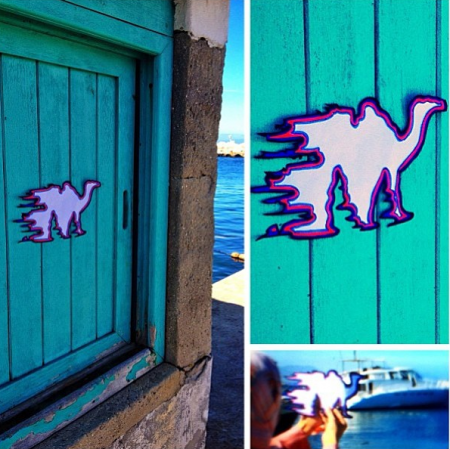
fatema_ak put up her camel in South Africa:
“I’m addicted to art and creative stuff, so when I saw the project I was excited to be part of it. My family and I were traveling to South Africa so I thought it would be great if I joined with a new place. I wanted the camel to be simple, so I just drew lines inside of it with blue and red: colours that are filled with energy and confidence.”

mahmoudforap with his camel in Sudan:
“I think 300 Camels is a really great project that symbolises love – love all around the world. My camel was put up at Nile Street in Khartoum: I chose the spot because I could take a picture of it with a view of the Nile. Then I also made a t-shirt with the camel in the colours of the Sudanese flag. I just wanted to do something new with the camel that no one had done before.”

moefirwana and his stencilled camel in Saudi Arabia:
“I believe art to be a universal language, that’s why I took part in the project. There’s a concrete barrier next to my house in Riyadh, that’s where I put up the camel. I chose that barrier because it represents street life, and indicates that art should not be restricted by any barriers. The camel has ‘300 Camels’ written in Arabic calligraphy: I wrote it to add some Islamic and Arabic strokes to it, which represent the area where I live.”

elaf_mh, also in Saudi Arabia:
“I found the project amazing and love that the name of the girl behind the project, Omamah, means ‘300 Camels’, and that she picked an icon that’s representative of Arab culture. I put up a camel at the Tahliyah Street Square in Riyadh – I didn’t do anything particularly creative with it, because I was afraid the police might catch me! But I want to do another, I’m just thinking about the right place.”







